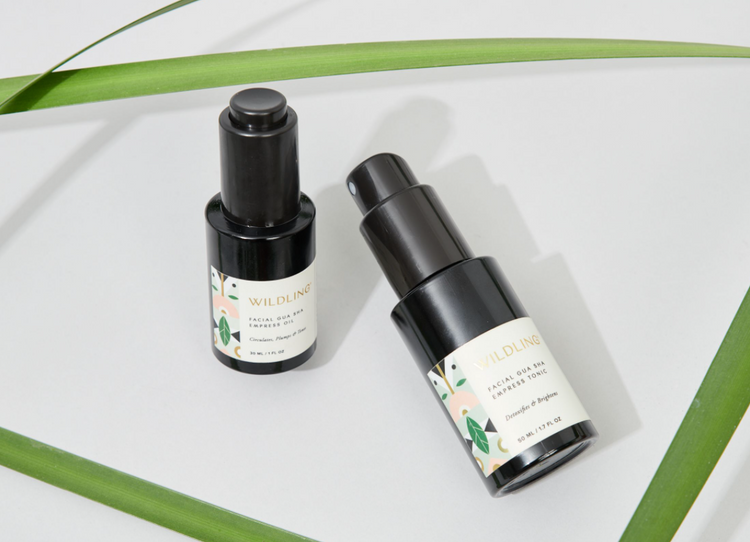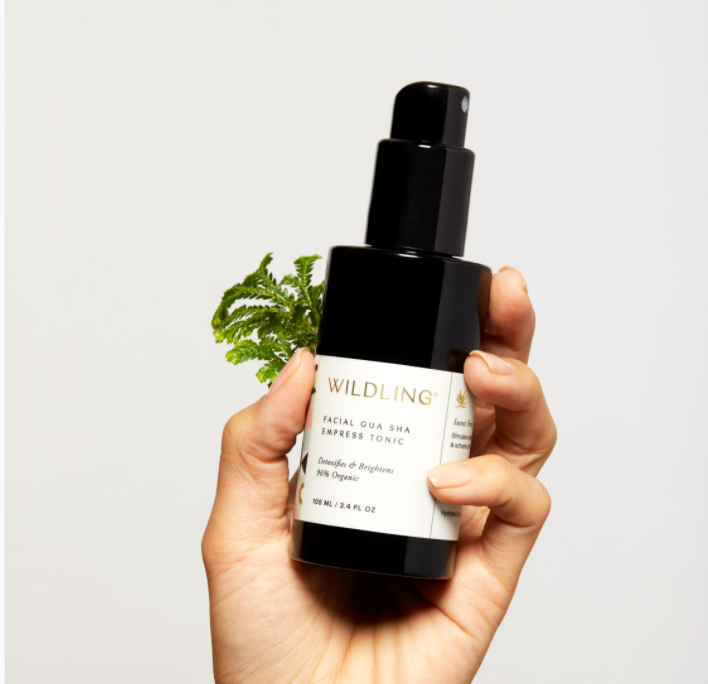Natural skin care products may seem new to the beauty industry, but they’ve been slowly gaining credibility, popularity, and market share for at least 15 years. What started as a fringe concept — using products from the earth that are good for us and for nature — has finally gone mainstream and it’s a win-win for everybody. Indie brands with healthy manufacturing, labor, and waste practices are getting the consumer support they deserve, people are recognizing that products can affect their health, and Mother Nature is both honored and prioritized. This is the best natural skin care scenario.
With thousands of all-natural skin care products on the market now, is it oversaturated? Have we created a ‘too much of a good thing’ problem? Sort of. We love that there are plenty of natural, green, and non-toxic skin care products to choose from. The conundrum now is, how do you pick the best ones? We’ll let you in on a secret: Not all-natural beauty products are created equal. This essential guide will help you develop a sense of discernment for the best natural beauty and personal care products and avoid the greenwashers.
The terms: Clean vs. green vs. natural vs. non-toxic, explained.
First, let’s clear up the terminology of clean beauty. If you’re new to this world, it’s easy to see why there is confusion about all of the different terms that are used to describe it. It’s difficult to find the best natural skin care routine! Clean, green, natural, all-natural, and non-toxic come to mind and are often used by brands and media interchangeably. As it stands now, all of the aforementioned terms are typically defined by brands themselves, as the cosmetics industry isn’t regulated in the United States the same way it is by countries in Europe. Can you believe it? Countries in the European Union (28 at the time of publishing this piece) ban more than 1,300 ingredients in their products while the US bans only 11. Ingredients like triclosan, selenium, nitrosamines, and 1,4 dioxane, all of which have been associated with health hazards, are allowed in the States but strictly banned in other countries.
The chief concern is that questionable ingredients like these will eventually make their way into the bloodstream and wreak havoc on the body as well as Mother Nature. It’s been shown that some percentage of our products do penetrate the epidermis and enter the bloodstream, but there isn’t much known about the effects of these chemicals on our body’s functions. The permeability of the skin depends on how healthy the barrier is and varies from person to person. What we do know, though, is that people with weakened immune systems, especially those with cancer, are encouraged to “clean up” their personal care products from even Western doctors — if that is true, wouldn’t we all want to steer clear of them?
At Wildling we believe that it’s important to have the facts so consumers can make informed decisions about how they proceed with skin and personal care. Perhaps what’s most frustrating is that all of these terms — natural beauty (or all-natural beauty), clean beauty, green beauty, and non-toxic beauty — are used interchangeably, even though they don’t necessarily have congruent meanings.
What do ‘natural skin care’ and ‘all-natural skin care’ mean?
Natural skin care or all-natural skin care are terms that brands and editorial outlets use to describe certain skin care products. As mentioned earlier, the FDA (Food and Drug Administration, the governing body for personal care and cosmetics) does not honor a formal definition of natural skincare or all-natural skin care, so it falls on brands and the press to articulate what natural means on a case by case basis.
Whether consumers realize it or not, the lack of regulation by the FDA shifts the burden to their shoulders to decide what products they ultimately deem safe and effective for use. On the one hand, harumph! That’s one more thing on the to-do list of consumers and arguably isn’t fair. On the other hand, it’s freeing to be able to educate yourself and choose a system of skin care and personal care products that work best for you.
In some instances, natural skin care means that the products are made with ingredients that are derived from nature. In others, it means ingredients are minimally processed during manufacturing, and in other instances, it refers to the process of omitting synthetics or using them sparingly. If you’re shopping and a product claims to be all-natural, look at the ingredients and the product description to glean more information about the product. Cross check our Do’s and Don’ts below to get a sense as to whether the product is made with care.
What does ‘clean skin care’ mean?
Like natural skin care, the term clean skin care is not regulated by the FDA and, therefore, is left up to interpretation by brands, the press, and consumers.
Here at Wilding, describing products as clean holds more weight than natural. Even if all ingredients in a product were nature-derived, sometimes the way they are processed makes them harmful to the body. Clean usually means that the ingredients have been vetted by some standards — whether that’s the EU’s stringent 1,300+ ingredient filter, a set of standards the brand has come up with on its own, credentials vetted by an expert or panel of experts like dermatologists, and/or standards put into place by organizations like the National Eczema Association, National Psoriasis Foundation, or the National Rosacea Society.
Again, our recommendation is to read the brand’s ingredient and sourcing philosophy to get a clear picture of what “clean beauty” means to them.
What does ‘non-toxic skin care’ mean?
Technically, non-toxic beauty products shouldn’t contain any “toxins.” Yes, indeed — toxin is a strong word. It warrants some deconstruction.
Toxic ingredients are any ingredients that science has linked to potential harm in the human body. Here’s the distinction that’s important to make: not all toxic ingredients are synthetic and not all non-toxic ingredients are natural. If only it were that simple!
Non-toxic skin care products have an important place in the better-for-you skin care market. In our ideal world, all products would be non-toxic. This is tough to define, once again, because the FDA has deemed only 13 ingredients toxic enough to be banned from the United States, so (do you notice a theme?) it’s up to brands to define for themselves what they consider toxic. If you’re feeling stumped or overwhelmed, keep reading — we provide a beginners’ guide to reading ingredient lists.
Why are natural skin care products better?
Natural skin care products are better because, in an ideal world, they are safer and more effective. Right now the natural and green beauty industry is in a major expansion phase, and unfortunately greenwashing is prolific. Greenwashing is when a brand uses words like natural, clean, and non-toxic to describe its products when the products themselves can irritate, sensitize, or harm the skin and the body. It’s essentially lying to the consumer using loopholes in the lack of regulation to say that the product is something it’s not. Don’t worry — in Clean Beauty 101 guide below, we teach you how to avoid greenwashing.
How to choose the best natural skincare.
As you're probably aware if you've read this far, it’s up to the consumer to choose skin care that best suits their needs, whether it’s natural, clean, non-toxic, or something else entirely. For better or for worse (we’re a little biased, but we think it’s actually quite fun), you will have to research the brands you’re interested in buying from — and most don’t publicly share the stories about how ingredients are sourced or processed. We encourage you to email brands with your questions and to advocate for the transparency you deserve!
But we understand that not everyone has the time to advocate. Here’s a quick checklist of what to avoid when you’re looking to buy natural skin care.
- Avoid artificial colors.
- If you have sensitive skin, steer clear of artificial fragrance (aka “parfum”) and essential oils.
- Avoid parabens (preservative), triclosan (preservative), formaldehyde (preservative which, believe it or not, is allowed in cosmetics in the States and often found in nail products and hair treatments), and phthalates, as they may cause disruption to the endocrine system.
- Phenoxyethanol is a common substitute for parabens that may be carcinogenic.
- PEGs or ethoxylated ingredients like Polyoxyethylene, Polysorbate-20, -40, -60, -80, Steareth-2, -4, -10, -16, -20, -2, and more.
- If you’re sensitive, avoid sulfates and sulfites, as they are known to be skin irritants.
Here’s a brief checklist of what to look for, but not all ‘good’ clean products need to have these features. However, it’s a good place to start.
- USDA Organic Certified means that the product is more than 95% organic, meets the requirements of ingredients that can and can’t be in products, and that the brand adheres to (and passes) a regimen of routine inspections by the USDA.
- Leaping Bunny Certification means that animal testing is not a part of the formulation and testing process.
- Oils that don't contain water-soluble ingredients don’t need preservatives, and therefore endure less processing.
- Whole plant distillations: this is how we create our plant and herb infused skin care products without using essential oils, which can be sensitizing.
How is Wildling different?
Wildling’s head of product development, Jill Munson, worked for years on the corporate side of both conventional and natural beauty brands. She combines this niche intel with her studies in herbalism, interest in natural beauty, and high development standards — with input from gua sha expert Britta Plug and traditional Chinese medicine practitioner Gianna de la Torre, L.Ac. — to create a line of products that is natural, non-toxic, clean, safe for sensitive skin, essential oil-free, highly vetted, and includes healing properties that work on an energetic level, too.
This only scratches the surface of the clean beauty conversation, but we hope you’ll join us every Monday for more. In the meantime, check out the all-star ingredient that sets our face oil apart and everything you need to know about facial gua sha, explained.

